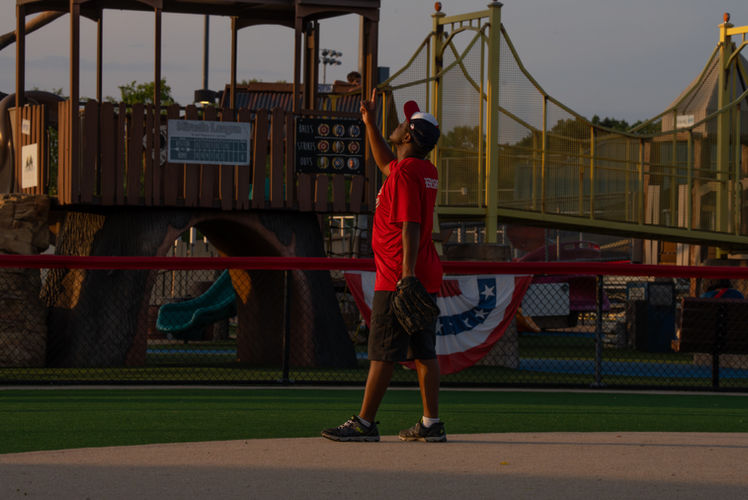-
A step up in baseball experience for athletes ready to advance their skills and understanding of the game.
-
Still built on fun, inclusivity, and teamwork, with added rules and gameplay dynamics.
-
Players explore multiple positions, develop teamwork, and refine baseball skills.
-
Game format: 75 minutes or 3 innings — more structure, still player-focused and enjoyable.
-
Coaches use teaching moments during play to build understanding of rules, strategy, and game flow.
-
Every athlete plays a meaningful role both on the field and at bat.
-
Games are played recording outs and runs scored, teaching the different emotions of winning and losing.
-
Maintains a non-competitive, encouraging environment — friendships, effort, and growth are celebrated.
-
Perfect for athletes transitioning from the Minor League or ready for a challenge while keeping the fun at the forefront.
-
View the full rules and game guidelines on the RULES page.
REGISTRATION
2026 Summer Season Registration: April 15 - May 15
Season: June 11 - August 22 (dates subject to change)
TEAMS

HOUSTON ASTROS

ST. LOUIS CARDINALS

BOSTON REDSOX

OAKLAND ATHLETICS

SEATLLE MARIINERS

CHICAGO WHITE SOX

COLORADO ROCKIES

WASHINGTON NATIONALS

KANSAS CITY ROYALS

ARIZONA DIAMONDBACKS
minor and major league divisions COMPARISON
What is the difference in game structure between the Minor and Major League Divisions?
-
Minor League: Games last 1 hour or 2 innings, whichever comes first. (subject to change)
-
Major League: Games last 75 minutes or 3 innings, whichever comes first. (subject to change)
How is batting handled in each division?
-
Minor League: Every player bats once per inning, with no strikeouts, walks, or outs. Players may use a tee if needed.
-
Major League: Each player bats once per inning, with up to 12 pitches per at-bat. If the player doesn’t hit after 12 pitches, they use a tee. Strikeouts and walks are not allowed. Players can get out.
Are there differences in base running?
-
Minor League: Players advance base-to-base after each hit, with the last batter running all bases for a home run. Overthrows do not impact play.
-
Major League: Players must stop advancing once the ball is in the infield or controlled by an outfielder, but cannot advance on overthrows or tag-ups.
How do defensive positions differ?
-
Minor League: There are no defensive positions. Often times, a player and their MVP will play catch in the outfield while the other team is up to bat.
-
Major League: Defensive players must remain in assigned positions, and rotation is required to ensure equal playtime. A maximum of 12 defensive players (6 infielders and 6 outfielders) are allowed (See defensive position chart for more information).
Are outs recorded in each division?
-
Minor League: Outs are not recorded, ensuring all players get to bat and score.
-
Major League: Outs are recorded, but the inning ends only when the batting team completes its lineup.
What equipment is used in each division?
-
Minor League: Only plastic or foam bats are allowed for safety.
-
Major League: Plastic, foam, metal, and wood bats are allowed. Helmets are required for all players in the batter’s box, on base, or in the on-deck circle.
What teaching moments are provided?
-
Both Divisions: Coaches are encouraged to use game pauses to explain rules or clarify calls for players.
Do both divisions have support systems on the field?
-
Minor League: Each athlete is paired with a Most Valuable Partner (MVP) for encouragement and assistance on the field. If a MVP is not available, coaches will encourage parents to join them on the field.
-
Major League: Independence is encouraged on the field. There are no MVPs to assist them. They lean on teammates and coaches for guidance and skill development.
Is there an age limit for Casey's Clubhouse?
-
Minor League: A player must be 5 years old by the start of the first day of the season. There is no age cap.
-
Major League: A player must be 16 years old by the start of the first day of the season. There is no age cap. A player must have played at least one year in the Minor League Division before being evaluated for the Major League Division.
What is the same across both divisions?
-
Focus on Fun and Inclusivity: Both divisions prioritize enjoyment, learning, and relationship-building over the outcome of the game.
-
Participation for All: Every player bats in each inning to ensure the players get to hit 3 times per game, and all games emphasize camaraderie over competition.
-
Emphasis on Teamwork: Players cheer for their teammates and celebrate everyone’s efforts, promoting a positive and supportive environment.



